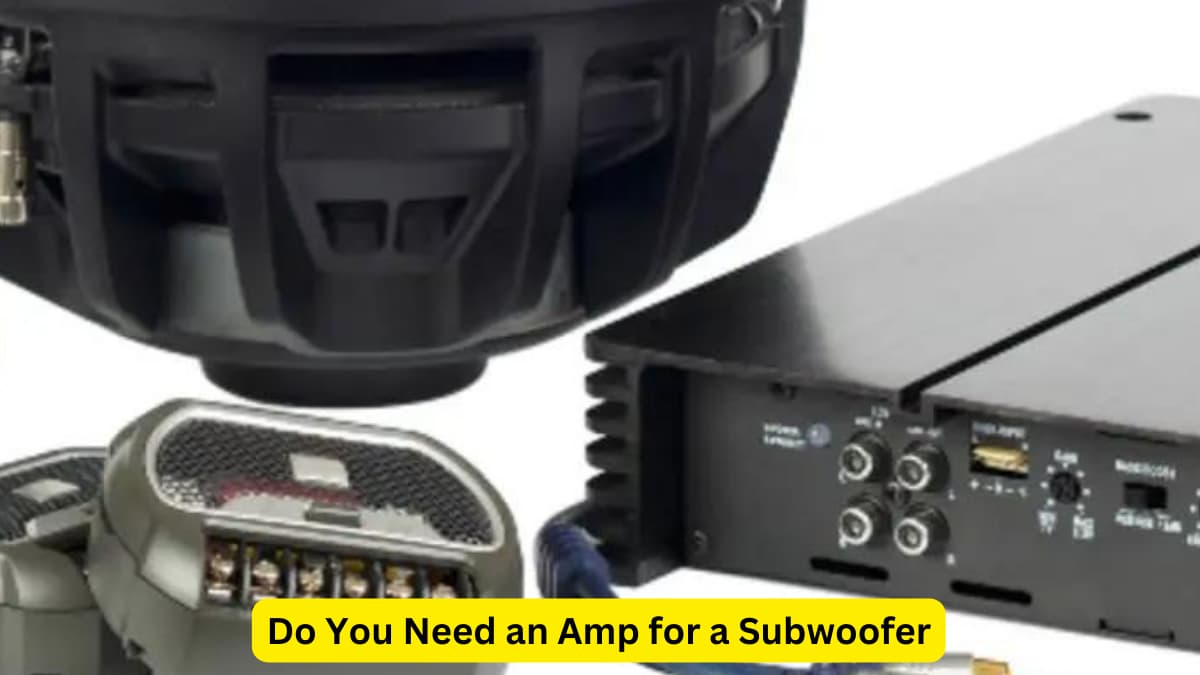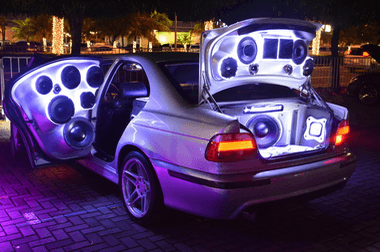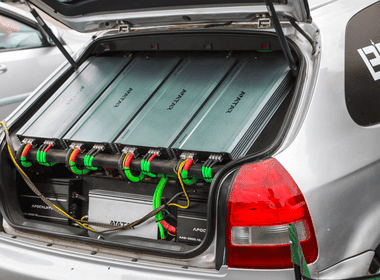Expert Answers: Do You Need an Amp for a Subwoofer?
The short answer is: most likely Yes.
You first need to determine what your goal is. If you are looking for really loud bass or high volumes, then getting an amp is an absolute must.
However if you want some entertainment for your daily commute you can enjoy the music without an amp.
Look:
For the rest I will reveal exactly why an amp is an absolute must for a great sounding system.
Just tell me already!
[lwptoc]
Do I Really Need an Amplifier?
There are a number of compelling reasons to install an amplifier in your vehicle stereo system after you’ve determined that the factory head unit with a built-in amp isn’t enough. Here are a few excellent reasons to add an amplifier to your car sound system.
If You Want More Bass
Any aftermarket amplifier will give you more bass, which is better for your factory speakers. You will enjoy deeper and louder bass thanks to a car amplifier.
It’s a common mistake: people think that the speakers are responsible for the bass. Sure, it’s true that they play a large part in how much bass you receive.
But so does the amplifier. No matter how good the speakers are, you can only achieve your best performance by adding.
If You Want Loud and Clear Sound Without Distortion
The factory head unit contains the amp and speaker, but not a very powerful one, so it cannot produce sound that is loud enough for most drivers. When you turn your stereo up, a factory head unit with an internal amp can’t play cleanly at high volume levels without distortion, which is why they often have variable loudness controls to compensate – and this feature lowers bass levels when the volume isn’t needed. With one or more strategically placed amps, you can set your loudness controls to maximum (or any level in between) and play music at full volume without distortion.
If You’re Looking to Power a Subwoofer
If you want to install a subwoofer in your car audio system, you’ll need a way to power it. Most factory head units don’t have the ability to add a subwoofer and an external amp, which means that you’ll need an aftermarket one to make your system really come alive.
If You Want the Best Out of Your Speakers
Most factory speakers come with low wattage ratings, which is why they cannot handle loud music without distorting it. A factory head unit with a built-in amp has limited power, which limits what you can do with your car speakers. A factory amplified head unit has limited power, so if you want the best sound possible, you will need an amplifier and a new head unit.
Aftermarket head units provide more power, giving you better range and bass. This allows full control over the bass, treble and midrange frequencies that come out of your speakers. In addition to allowing better control over sound output, installation of a new head unit is easy.
If You’re Looking for More Flexibility and Features
Aftermarket amplifiers naturally offer more features, such as separate subwoofer controls and crossover settings. In addition, many amps include equalizers or signal processing. Signal processing allows you to enhance your music and tailor it to your specifications. For example, if a song has intense bass that drowns out the treble, a signal processor can remove some of the low frequency sounds and boost those in the higher frequencies.
Related: Best equalizer settings for bass
What are car amplifiers used for?
Most factory sound systems include a head unit (which means the receiver/radio itself and the physical buttons) and speakers. The way these systems work is that the head unit contains a small built-in amplifier. The amplifier is what powers the speakers. This amplifier takes the audio signal and amplifies it.
Why you need an amp to power a subwoofer?
For standard systems, this built-in amp isn’t very powerful, but for premium or high-powered audio systems, it might be able to deliver more power. Since this amplifier is built into the head unit, it isn’t very powerful. This means that factory sound systems cannot produce a lot of bass without distorting the music.
To get the best sound possible from your automobile stereo, you’ll need to replace the speakers as well as add an amplifier.
Conclusions on: Do you need an amplifier for a subwoofer
When it comes to sound quality, installing an amplifier is the best way to make your system complete. You’ll get improved bass and cleaner power with any aftermarket amplifier. With an amp, you can play music at high volumes without distortion no matter how good your factory speakers are. An amp also allows for more bass whereas a factory head unit contains the amp and speaker but not a very powerful one. Installing an aftermarket head unit is easy and installing one or more strategically placed amps will allow you to set your loudness controls to maximum (or any level in between) without distortion. You’ll need an amplifier if you want excellent sound quality.
Related: The best subwoofers for cars reviewed (with buying guide)
Frequently Asked Questions:
What’s the difference between active subwoofers and passive subwoofers?
The difference between an active subwoofer and a passive subwoofer is the power source. The active sub is also called powered subwoofer which means that the power source is included in the box. This will make your car stereo install much simpler.
Should I choose an active or powered subwoofer?
There are many benefits for an active subwoofer over a passive subwoofer when you configure your car stereo. Having a powered subwoofer means that there’s no guesswork if you got the right subwoofer or amp. The powered subwoofers are typically plug and play so the installation is a lot simpler.
What are the benefits of an external amplifier for the car stereo?
The external amplifier for a car stereo can do wonders. The car subwoofer will produce distortion free sound for the car audio system. Typically without an amp the standard speakers and the subwoofer output won’t produce a louder sound and the bass frequencies will be flat.
How do you connect a subwoofer to an amp?
It’s quite easy to connect a subwoofer to an amp. Typically amps have a dedicated channel just for subs so you connect the speaker wires to that channel. It’s a bit different with coaxial speakers and a mounting dock.
Can I just add a subwoofer to my car?
Well you can try it. The thing about the subwoofer is that it needs power or there will be no bass. So if you’re adding an aftermarket subwoofer you will need an amp as well.
Can you just use a subwoofer?
No subwoofers only deliver the low (bass) frequencies you will need speakers to reach the mids and highs.
What type of amplifier do I need for a subwoofer?
For a subwoofer you will need a monoblock class D amplifier this will bring out the best from your subwoofer.
Do I need an amp for my subwoofer?
Yes, a powered subwoofer requires an amplifier in order to process the audio signal and increase the power output for deeper bass frequencies.
What does an amp do for a subwoofer?
An amplifier is necessary to provide power and control to a subwoofer. It amplifies the incoming electrical audio signal so that it can be processed efficiently by the driver and create sufficient sound pressure levels with low distortion. Additionally, some amplifiers have adjustable frequency crossover point and phase switch options that allow you to fine-tune the performance of your system.
Do I need an amp for subs?
Yes, most subs require amplification – usually through an average home theatre receiver or dedicated right amplifier – in order to perform optimally. Without one, there will likely be poor sound quality and low volume output. However, some car subwoofers are designed without amplifiers included as they are intended to be connected directly to a factory head unit instead of using external amplification.
What impedance values should I consider when selecting an amplifier vs a subwoofer?
It is important to match the impedance rating of your amplifier with that of your subwoofer in order for them both to work optimally together; this helps ensure efficient power transfer between the two components while also protecting against any damage from mismatched impedance values. Using too low or too high of an impedance rating can lead to overheating issues or lacklustre performance at best! When choosing components for your home theater system, double check their matching impedance ratings before confirming your purchase.
Do active subwoofers have built-in amplifiers?
Yes, many active subwoofers come with built-in amplifiers for a convenient and powerful audio setup.
Can you use an amp without a subwoofer?
Yes, you can use an amplifier to power other speakers or components without using a subwoofer.
Does a subwoofer need an amplifier?
Yes, most subwoofers require dedicated amplification in order to produce sound at sufficient volume levels.
What is the difference between an amplifier and a subwoofer?
An amplifier supplies power to drive speakers while a subwoofer is designed specifically to reproduce low frequencies. Additionally, different models of each will have varying impedance values and preamp line outputs as well as different power outputs.
Do you have to have an amp for a subwoofer?
No, you do not have to have an amplifier for a subwoofer. It depends on the type of subwoofer you are using – if it is a passive (non-powered) subwoofer, then you would need an external amplifier to power the signal. But if it is an active (powered) subwoofer, then there is no need for an extra amplifier as the signal has already been amplified.
Does a powered subwoofer need an amplifier?
No, powered subwoofers do not require additional amplifiers as they come with built-in amplification circuits that allow them to drive low frequency signals without any extra assistance from outside sources.
Can you run a sub without an amp?
Yes; if your subwoofer is passive (non-powered), then in order to operate it correctly you must use an external amplifier and RCA cables or speaker wire in order to send the audio signal from your source device into the amplifier and out through the speakers/subs. However, if your subs are powered/active, no additional amplifying equipment is required as they already contain built-in amplification circuits inside them.
Do powered subwoofers need an amp?
No; while some people believe that adding more power will increase their sound quality and volume levels, this isn’t always true. Powered/active subs don’t require additional amps as they already come equipped with reliably powerful internal amps that can handle most audio sources without issue.
What is frequency response?
Frequency response is the measure of how a device responds to different frequencies, usually measured in Hertz (Hz) and decibels (dB). It is an important factor when selecting audio equipment, as it determines how well a speaker or amplifier will be able to reproduce low frequency sounds.
Do you need an amp for a subwoofer?
Yes, most subwoofers require an external amplifier to function properly. Amp matching can be critical and affects performance significantly. If you are looking for a subwoofer that doesn’t need an amp, look into active models with built-in amplifiers.
Do you need an amplifier for home theater receivers?
It depends on the receiver model and your preferences. Some receivers come with built-in amplifiers while others don’t so they may require additional preamp outputs in order to use them without needing an amplifier. The amount of power needed also varies depending on your setup so it’s best to check the specifications of your receiver before deciding whether or not you need an amplifier.
How much power does a subwoofer amp provide?
The amount of power that a subwoofer amp provides depends on its wattage rating. Generally speaking, higher wattage amps will offer more power than lower wattage amps but this ultimately depends on the specific model and can vary from brand to brand.
Last Updated on November 7, 2023 by Brian Beasley





